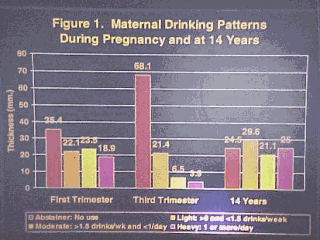 |
The heaviest drinker in our study drank 22 drinks a day
through the first five months of pregnancy. And then she quit cold turkey for months five,
six, and seven, and then started drinking again. She had a child that had the facial
features, some of the morphological features, and some of the CNS features of FAS but it
wasn't growth retarded because she wasn't drinking during the critical growth period. What
struck us, is that this rate goes? So it struck us that this was a good time to intervene.
They're able to decrease their drinking during pregnancy, and mother nature helps them a
little by changing their taste sensations, so drinking alcohol becomes unpleasant. That
biological phenomenon disappears at birth. The motivational phenomenon is the same: even
an alcoholic will stop drinking during pregnancy, but as soon as she gives birth, she goes
back to drinking. What's also interesting is that though they decrease the quantity, they
don't decrease the frequency, so what they're leaving in place is the behavior. |
